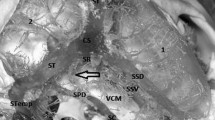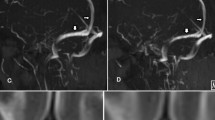Summary
Using a newly devised model of dural sinus occlusion, we investigated the pathophysiology of venous haemorrhage as well as venous circulatory disturbance. The superior sagittal sinus (SSS) and diploic veins (DV) were occluded in 16 cats. Intracranial pressure (ICP), cerebral blood volume (CBV) and regional cerebral blood flow (rCBF) were measured for 12 hours after the occlusion. At the end of the experiment, cerebral water content was estimated. In another 8 cats additional occlusions of cortical veins were carried out. In both groups, the blood-brain barrier permeability was evaluated with Evans blue or horseradish peroxidase.
The SSS and DV occlusion produced a significant increase in ICP and CBV concomitant with a significant decrease in rCBF. Cerebral water content also increased significantly. However, there was no transition of Evans blue and horseradish peroxidase through the cerebral vessels, and no haemorrhages could be observed. In contrast, the additional occlusion of cortical veins produced haemorrhagic infarctions with Evans blue extravasation in 6 out of the 8 cats.
These data suggest that dural sinus occlusion may lead to an increase in CBV and cerebral water content resulting in intracranial hypertension and decreased rCBF. The brain oedema in this model seemed to be mainly hydrostatic oedema, and might also be contributed by cytotoxic oedema. The additional occlusion of cortical veins might be essential in the development of haemorrhage in this model, and the blood-brain barrier was also disrupted in these areas.
Similar content being viewed by others
References
Aukland K, Bower BF, Berliner RW (1964) Measurement of local blood flow with hydrogen gas. Circ Res 14: 164–187
Beck DJK, Russel DS (1946) Experiments on thrombosis of the superior longitudinal sinus. Neurosurgery 3: 337–347
Bousser MG, Chiras J, Bories J, Castaigne P (1985) Cerebral venous thrombosis — a review of 38 cases. Stroke 16: 199–213
Fries G, Wallenfang T, Hennen J, Velthaus M, Heimann A, Schild H, Perneczky A, Kempski O (1992) Occlusion of the pig superior sagittal sinus, bridging and cortical veins: multistep evolution of sinus-vein thrombosis. J Neurosurg 77: 127–133
Fujita K, Kojima N, Tamaki N, Matsumoto S (1985) Brain edema in intracranial venous hypertension. In: Inaba Y, Klatzo I, Spatz M (eds) Brain edema. Springer, Berlin Heidelberg New York Tokyo, pp 228–234
Kety SS, Shenkin HA, Schmidt CF (1948) The effects of increased intracranial pressure on cerebral circulatory functions in man. J Clin Invest 27: 493–499
Krayenbühl HA (1966) Cerebral venous and sinus thrombosis. Clin Neurosurg 14: 1–24
Kurokawa Y, Hashi K, Okuyama T, Uede T (1990) Regional ischemia in cerebral venous hypertension due to embolic occlusion of the superior sagittal sinus in the rat. Surg Neurol 34: 390–395
Kuayma H, Fujimoto S, Nishimoto K, Ninomiya K, Akioka T, Matsumoto A, Nishimoto A (1978) Measurement of regional cerebral blood volume by photoelectric method. (In Japanese) Neurol Med Chir (Tokyo) 18: 655–664
Kyoi K, Tsujimoto S, Sakaki T, Yokoyama K, Morimoto T, Utsumi S (1988) Experimental studies on cerebral hemodynamics in venous circulatory disturbance; reversibility of cerebral blood circulation and sinus occlusion. (In Japanese) J Nara Med Ass 39: 414–420
Marmarou A, Poll W, Shulman K, Bhagavan H (1978) A simple gravimetric technique for measurement of cerebral edema. J Neurosurg 49: 530–537
Mayhan WG, Heistad DD (1986) Role of veins and cerebral venous pressure in disruption of the blood-brain barrier. Circ Res 59: 216–220
Miller JD (1979) The management of cerebral oedema. Br J Hosp Med 21: 152–165
Reese TS, Karnovsky MJ (1967) Fine structural localization of a blood-brain barrier to exogenous peroxidase. J Cell Biol 34: 207–217
Saijo T, Gotoh M, Nishino S, Shirakawa T, Niimi H, Murota T, Kuyama H, Ohmoto T, Nishimoto A (1993) Experimental study on cerebral venous circulatory disturbance. Intracranial Pressure VIII (in press)
Sato S, Toya S, Ohtani M, Kawase T (1985) The effect of sagittal sinus occlusion on blood-brain barrier permeability and cerebral blood flow in the dog. In: Inaba Y, Klatzo I, Spatz M (eds) Brain edema. Springer, Berlin Heidelberg New York Tokyo, pp 235–239
Shulman K, Verdier GR (1967) Cerebral vascular resistance changes in response to cerebrospinal fluid pressure. Am J Physiol 213: 1084–1088
Symon L, Branston NM, Chikovani O (1979) Ischemic brain edema following middle cerebral artery occlusion in baboons: Relationship between regional cerebral water content and blood flow at 1 to 2 hours. Storke 10: 184–191
Tomita M (1988) Significance of cerebral blood volume. In: Tomita M, Sawada T, Naritomi H, Heiss WD (eds) Cerebral hyperemia and ischemia: from the standardpoint of cerebral blood volume. Elsevier, New York, pp3–31
Tychmanowicz K, Czernicki Z, Czosnyka M, Pawlowski G, Uchman G (1990) Early pathomorphological changes and intracranial volume-pressure: relation following the experimental sagittal sinus occlusion. Acta Neurochir (Wien) [Suppl] 51: 233–235
Wagner EM, Traystman RJ (1983) Effects of cerebral venous and cerebrospinal fluid pressure on cerebral blood flow. In: Auer LM, Loew F (eds) The cerebral veins. Springer, Wien New York, pp 223–230
Author information
Authors and Affiliations
Rights and permissions
About this article
Cite this article
Gotoh, M., Ohmoto, T. & Kuyama, H. Experimental study of venous circulatory disturbance by dural sinus occlusion. Acta neurochir 124, 120–126 (1993). https://doi.org/10.1007/BF01401133
Issue Date:
DOI: https://doi.org/10.1007/BF01401133




